Gallery Network
Open Studios: Get to Know Emily Manwaring, a Brooklyn-Based Painter Who Captures the Joy of Being Surrounded by Loved Ones
Get a closer look at new artists' practices via digital showcases of their works.
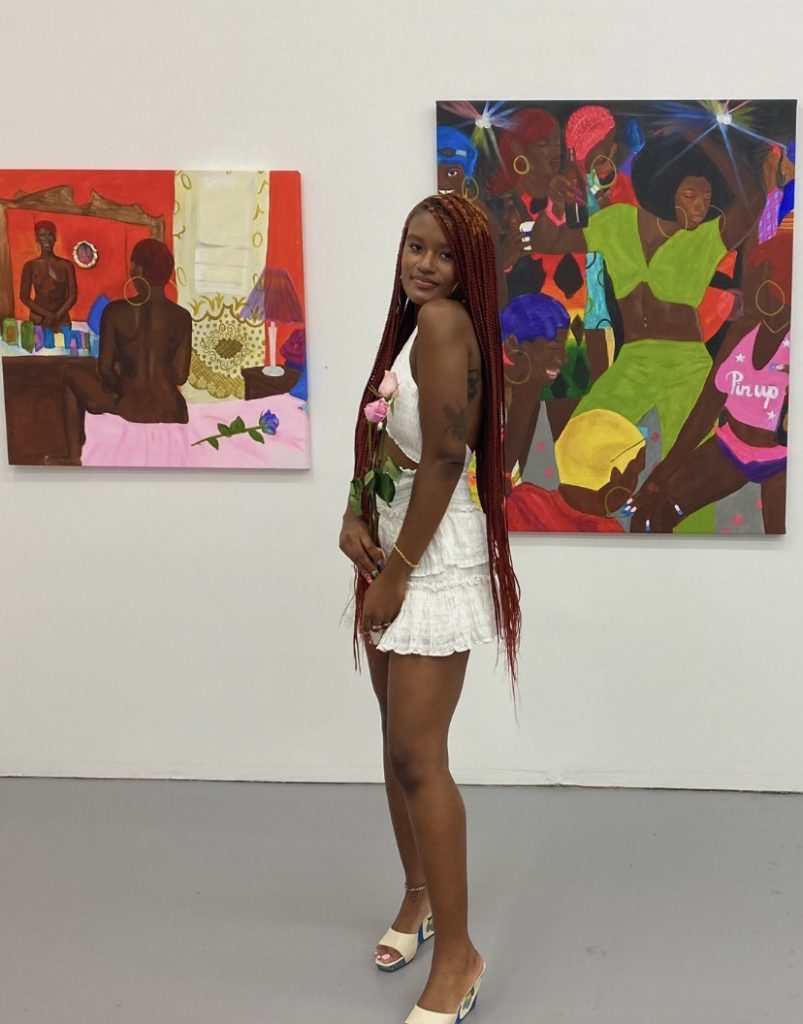
Get a closer look at new artists' practices via digital showcases of their works.

Artnet Gallery Network

Artnet Open Studios is a curatorial project produced by the Artnet Galleries team that grants underrepresented artists the distinct benefits of Gallery Network membership. This initiative widens the scope of discovery by featuring BIPOC artists who are actively expanding their online presence and collector relationships. Open Studios takes a closer look into the artists’ practices with digital showcases of their works.
Brooklyn-based artist Emily Manwaring is an interdisciplinary artist who works primarily in collage and painting to create vibrant visions of New York’s Caribbean communities. The works are intimate snapshots of people’s lives—we see a couple leaning against one another asleep on a crowded train and children playing in a blow-up pool in a fenced-in backyard.
The artist took up painting as a means of working through her understanding of her own identity and personal traumas, often using family photo albums as a point of departure. Strongly influenced by the works of Kerry James Marshall and Faith Ringgold, Manwaring sees her work as a place to bear witness to Black joy as well as a means in which to process the experiences of time and emotion.
Below, we talked to Manwaring about her practice.
Name: Emily Manwaring
Age: 22
Hometown: Queens, New York
Current City: Brooklyn, New York
Medium(s): Manwaring is an interdisciplinary artist working primarily in painting, sculpture, and collage.
How did you find your way to the art world?
I first became interested in art as my way of escaping the reality I lived in. Painting was a way of creating a completely new environment and I could immerse myself within it. It was my way of getting out of trouble and staying focused on something more positive. Growing up, it was difficult for me to understand my identity; through self-portraiture, I was able to imagine myself taking up different forms and growing into more courage.
When I first began, I worked with a lot of my family archives and photo albums. I was dissecting more of the trauma in my childhood and past. Doing this allowed me to understand placement as an artist and also helped ground me in my own life.
Now, in my practice, I use more of my present experiences as a reference and I think more about how joy is shared with others, especially in Black culture. Compositionally in my work, I’m more interested in collage and how it can create shape within the canvas. Painting will always be a way to help me process emotion and time. Today, I can say my work is more universal and carries the many experiences of daily life that are shared with loved ones.
Describe your work in your own words.
The collage aspect of my work creates the different dimensions of the past, present, and future of my life. These are rooted in a shared experience of the loved ones around me. The color and vibrancy reflect the luminosity in my life in those moments. A lot of my practice incorporates both Caribbean and New York culture with my family being from Haiti and Trinidad and living in the city.
Who are your artistic heroes and why?
Kerry James Marshall and Faith Ringgold are my artistic heroes, hands down. Since the beginning of my practice, these two artists inspired me to keep growing.
I have a specific memory that connected me to Faith Ringgold’s work early on in my life. My elementary school would host weekend art workshops. One Saturday, there was a workshop based on Faith Ringgold’s quilts and books and my mother and I created a quilt based on the book Tar Beach. That was my first time creating a quilt and it will always be a special memory for me. I felt at home looking at her quilts; reading through the books, I would lose myself in the patterns and stories within the fabrics and illustration.
Kerry James Marshall was one of the first painters I remember hearing about. His attention to color and shape encouraged me. I’ve always been interested in the themes within his work because it felt like I was seeing my own life and those of my loved ones. One of the first times I saw his paintings in person was the piece Black Star 2 when I was in high school. I remember that feeling of being represented in a space and seeing someone who looks like me looking back at me. Not going to lie, I spent so long in front of that piece just staring, I lost the tour group I was with. Then I realized that making this work and freezing these moments in time is important. Seeing his paintings also made me think about scale and how painting can take up space.
What inspires you?
My greatest inspiration is the music that I listen to daily. There is so much imagination held within the melodies and notes. A lot of album covers made by artists also create a story along with the music. One of my favorites is Corky Mccoy, who created the cover art for Miles Davis’s “Water Babies” and “Miles Davis on the Corner.” Here’s a playlist of some songs that spark motivation in me.
My friends and loved ones are another big motivation—the experiences we share keep color vibrant in my work. Even dreams inspire me; I go through plenty of ideas in one day and I keep a thread of them typed out. There are ideas that I haven’t even executed yet from years back, but there is also a beauty in watching the ideas grow in different patterns as time passes and life changes.
If you could own any work of art in the world what would it be?
If I could own any artwork in the world, it would of course be the Tar Beach quilt, Woman on a Bridge, by Faith Ringgold. I can only imagine. As I think about it hung on my wall, I think about my grandmother’s house and how it would pay homage to that.
I would also love to own Night Watchers by Tunji Adeniyi-Jones. The fluidity in this piece reminds me of the grace and power in my own body. I can imagine these two works hanging in my home in conversation with each other.
Browse works by the artist below.
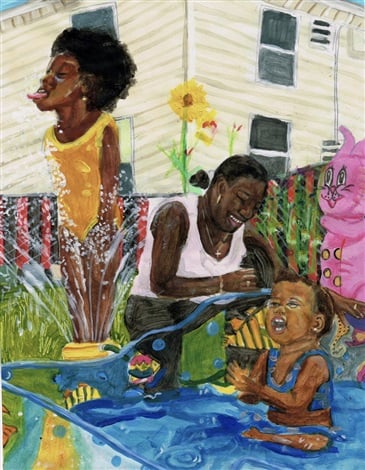
Emily Manwaring, Found a pocket of joy in the grass this afternoon (2020). Courtesy of the artist.
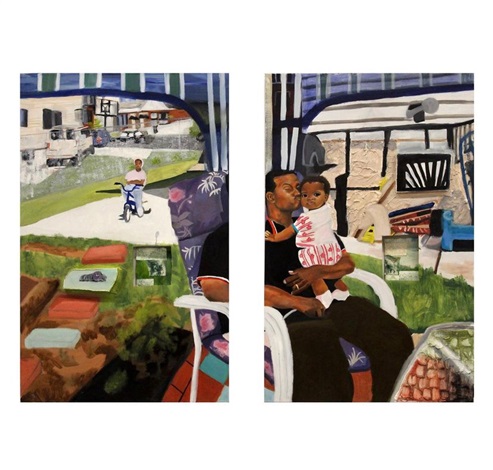
Emily Manwaring, I of the Beholder (2019). Courtesy of the artist.
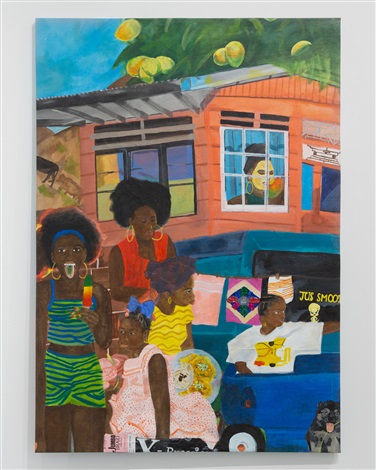
Emily Manwaring, When the wheels are turning there is no going back (2020). Courtesy of the artist.
E Train to Jamaica Center (2020)
Inquire for More Information
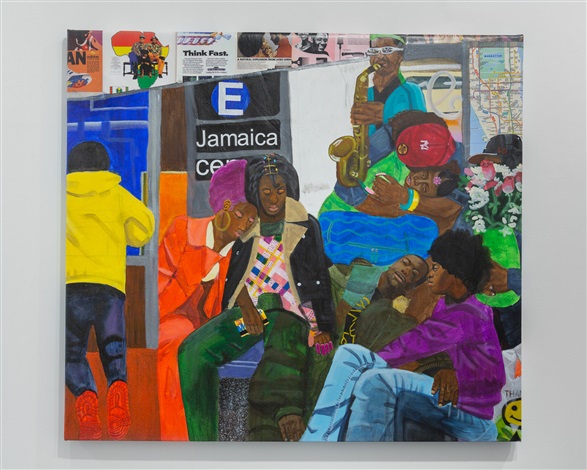
Emily Manwaring, E Train to Jamaica Center (2020). Courtesy of the artist.